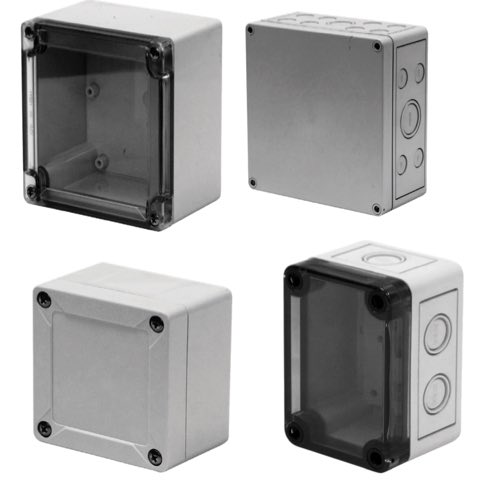nVent Hoffman Polystyrene Enclosures

nVent Hoffman polystyrene enclosures are designed to provide reliable protection for electrical and electronic components. Hoffman polystyrene enclosures are available in various sizes and configurations to suit different applications.
One of the advantages of nVent Hoffman polystyrene enclosures is their lightweight design, which makes them easy to handle and install. They are also cost-effective compared to other materials like metal and fiberglass. Additionally, polystyrene is non-conductive, which can be an important consideration in certain applications where electrical insulation is required.
nVent Hoffman polystyrene enclosures feature snap-on covers, making them easy to install and maintain. They are available in different colors, including white and gray, and can be customized with cutouts and other modifications to meet specific application requirements.
More Information about nVent Hoffman Non-Metallic Enclosures
nVent Hoffman polystyrene enclosures are also resistant to chemicals and UV radiation, making them suitable for use in outdoor environments. However, they may not be as durable as other materials like metal and fiberglass and may not be suitable for high-impact applications.
nVent Hoffman polystyrene enclosures are designed to meet various industry standards, including NEMA (National Electrical Manufacturers Association) and UL (Underwriters Laboratories) standards. They also offer different IP (Ingress Protection) ratings, depending on the specific model, which determines the enclosure's ability to protect against dust and water ingress.
nVent Hoffman non-metallic enclosures are available in a wide selection of sizes and configurations. You can find them as junction boxes, wall-mount enclosures, and free-standing enclosures. And you get mounting options and accessories that make these enclosures usable. nVent Hoffman provides an array of ways to mount your equipment inside the enclosure. You can also buy back panels, hinged covers, and padlocking provisions to keep things secure. These conveniently available accessories make configuring and using the box a snap. In this feature-rich environment, you can put just about anything you need to house into a nVent Hoffman non-metallic enclosure.
Non-Metallic Enclosure Types
Characteristics of non-metallic enclosures:
NEMA 4x rating for outdoor use providing chemical resistance and protection from dust, debris, water and rain.
High insulation value, which provides insulation from cold and hot temperatures, but does not dissipate heat from inside the enclosure.
Non-conductive, meaning components cannot be grounded to the enclosure, but it still provides the same security and tamper resistance levels as metallic enclosures when properly locked.
Types of non-metallic enclosures:
Fiberglass
A thermoset polyester material reinforced with glass fibers. It is the most widely used non-metallic material in the industry. It has high impact strength and rigidity (dimensional stability), a superior working temperature range (-31˚F to 300˚F), excellent electrical properties, moisture and chemical resistance, as well as being cost effective.
Polycarbonate
High-performance thermoplastic resin processed by injection molding or sheet extrusion. It has superior impact resistance, good rigidity (dimensional stability), an extended temperature range (-31˚F to 180˚F), excellent electrical properties, fire retention, UV stability and corrosion resistance in some acidic surroundings. It is not suitable for environments with strong alkalis and organic solvents.
ABS or ABS blends
Acrylonitrile Butadiene Styrene is a common thermoplastic polymer processed by injection molding. It has high impact resistance, but less impact resistance in cold weather compared to polycarbonate, excellent electrical properties, superior chemical and moisture resistance, but a narrower temperature range than fiberglass (-40˚F to 248˚F).
Polyester
High-performance unfilled thermal plastic processed by injection molding. It has high impact resistance, but less impact resistance in cold weather than polycarbonate, excellent electrical properties, superior chemical and moisture resistance, but a narrower temperature range than fiberglass (-40˚F to 248˚F).

